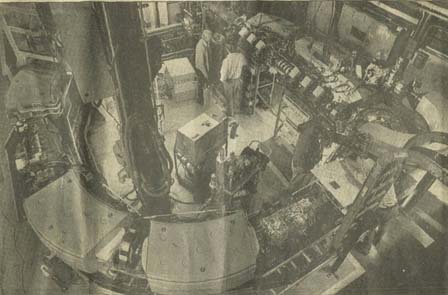New Proton Accelerator Draws Bead on Cancer Cells

This proton therapy accelerator at Fermilab near Batavia will be shipped to Loma Linda University Medical Center in California for use in a revolutionary new treatment of cancer patients
Using technology they developed to hunt for quarks and other exotic natural particles, Fermilab scientists have produced a unique roomsize proton accelerator that may be able to kill cancer cells better than any other type of radiation.
The compact accelerator is designed to do something that other radiation devices cannot -- destroy diseased cells while leaving healthy cells basically unharmed.
It's a revolutionary treatment," said Philip Livdahl, former Fermilab deputy director and now project manager for Loma Linda University Medical Center in Loma Linda, Calif., where the new machine is expected to begin work this summer.
"When this technology reaches its full potential, I think it will replace X-rays and other forms of radiation for cancer therapy."
X-rays and gamma rays,which are now used to destroy cancerous tissue, pass through the body, causing damage along the entire length of their paths. Radiation kills cells by destroying genetic machinery.
Because these radiation beams destroy healthy tissue before reaching a tumor, physicians often have to reduce the destructive dose of the beams, which may reduce the ability of the radiation to kill the cancer.
A proton beam, on the other hand, overcomes this drawback by delivering a much higher radiation dose to the tumor than it does to surrounding tissue.
The proton beam can be focused to release its destructive radiation at any target within the body, such as a tumor, without destroying normal cells along the route of the beam. Protons are subatomic particles found in the nuclei of atoms.
A proton beam enters the body at an energy low enough not to damage tissue. The beam then slows down and stops at a point that can be exactly determined.
When the beam stops at its target, it is absorbed by atoms there, releasing nine times more energy than it had when it entered the body. It is this energy released at the target that destroys the tumor.
Combined with new imaging devices that produce three-dimensional pictures of the interior of the body, including precisely outlining the boundary between cancerous and healthy tissue, a proton beam can be used to eradicate a cancer with surgical accuracy, said Dr. James Slater, a Loma Linda cancer specialist.
"In order for cancer radiation therapy to advance we needed to improve our ability to focus a beam inside the body. The proton accelerator does that," he said. "It's a superior tool that's going to produce a major improvement in cancer therapy."
The accelerator, which is undergoing shakedown tests at Fermilab, is one of the promising spinoffs from high-energy physics research at the center, located near Batavia. A product of the laboratory's program to find practical uses for its specialized technology, the machine is the first proton therapy accelerator designed exclusively for patient treatment.
"We're all excited about the physics going on at Fermilab, but we appreciate the opportunity to do something real with what we've learned over the years to help mankind," said Livdahl.
Doctors have known that proton beams might be a powerful weapon against cancer, but the technology to produce flexible beams in adequate amounts has not been available.
Patients had to travel to physics research facilities where particle accelerators could be used for cancer therapy when they were not occupied smashing atoms. These beams, furthermore, were not flexible, so few types of cancer could be treated.
As a result, only a small number of patients have been treated with proton beams-about 6,000 over the last 15 years. But the results have been so good that physicians expect the technique will result in more cures.
One of the most dramatic improvements has been achieved with an eye cancer known as ocular melanoma, a tumor that grows on the inside of the eye. Standard therapy, which consisted of removing the eye, produced dismal results, with the cancer reappearing at some other site in the body in 65 percent of patients.
Since physicians started treating this cancer with a proton beam produced by an old atom smasher at Harvard University, however, they have been able to eliminate the cancer in 96 percent of cases without having to remove the eye, said Livdahl.
Furthermore, there is no loss of vision in 75 percent of the treated eyes, he said.
In an effort to break the logjam over the limited availability of proton beams, Loma Linda officials in 1986 asked Fermilab physicists if they could build an accelerator to produce protons for cancer therapy. Loma Linda is building a new $40 million proton beam radiation facility.


